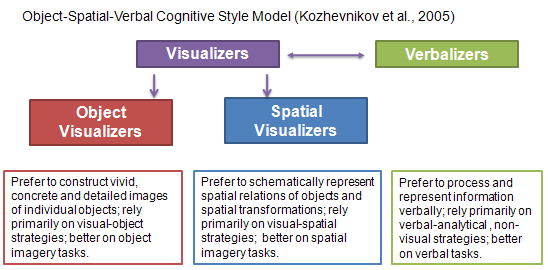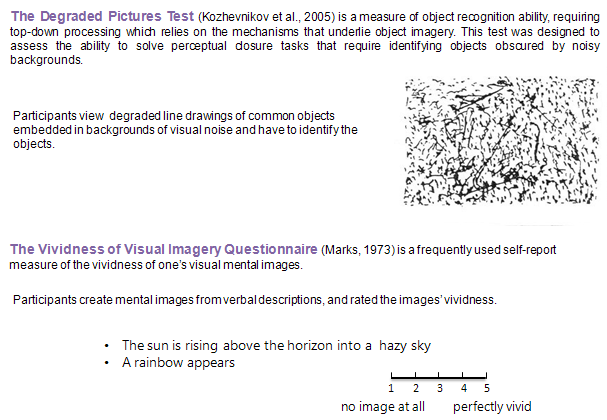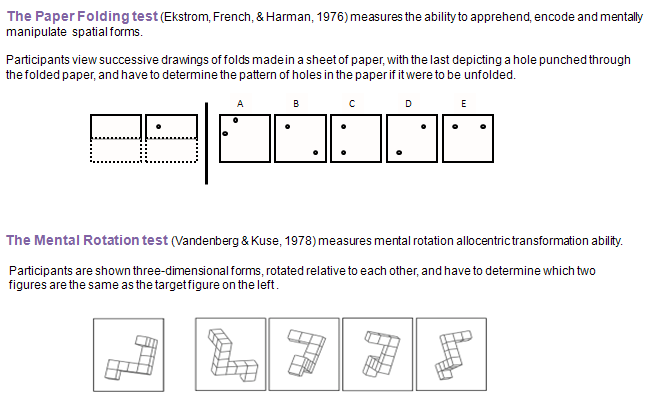Mental Imagery and Human-Computer Interaction Lab
Object-Spatial-Verbal Cognitive Style Model
Kozhevnikov, Kosslyn, & Shephard (2005) proposed the new Object-Spatial-Verbal theoretical model of cognitive style that identifies three relatively independent dimensions: Object Imagery, Spatial Imagery, and Verbal.  This model re-examined the traditional Visual-Verbal cognitive style model
, in accordance with current behavioral and neuroscience findings, demonstrating the dissociation between the object and spatial processing systems
. Blazhenkova & Kozhevnikov (2009), based on the results of confirmatory factor analysis, demonstrated that the overall fit of the data to the new three-dimensional model of cognitive style was significantly better than that to a traditional model
This model re-examined the traditional Visual-Verbal cognitive style model
, in accordance with current behavioral and neuroscience findings, demonstrating the dissociation between the object and spatial processing systems
. Blazhenkova & Kozhevnikov (2009), based on the results of confirmatory factor analysis, demonstrated that the overall fit of the data to the new three-dimensional model of cognitive style was significantly better than that to a traditional model
 This model re-examined the traditional Visual-Verbal cognitive style model
, in accordance with current behavioral and neuroscience findings, demonstrating the dissociation between the object and spatial processing systems
. Blazhenkova & Kozhevnikov (2009), based on the results of confirmatory factor analysis, demonstrated that the overall fit of the data to the new three-dimensional model of cognitive style was significantly better than that to a traditional model
This model re-examined the traditional Visual-Verbal cognitive style model
, in accordance with current behavioral and neuroscience findings, demonstrating the dissociation between the object and spatial processing systems
. Blazhenkova & Kozhevnikov (2009), based on the results of confirmatory factor analysis, demonstrated that the overall fit of the data to the new three-dimensional model of cognitive style was significantly better than that to a traditional modelBased on the new Object-Spatial-Verbal cognitive style theoretical model, Blajenkova, Kozhevnikov, & Motes (2006) first designed and validated a new self-report instrument assessing individual differences in object imagery and spatial imagery (Object-Spatial Imagery and Verbal Questionnaire; OSIQ), and Blazhenkova and Kozhevnikov (2009) developed an extended version of the OSIQ that included verbal scale ( Object-Spatial Imagery and Verbal Questionnaire
; OSIVQ). Furthermore, based on the OSIVQ, Blazhenkova, Becker, and Kozhevnikov (in press) designed a new self-report instrument, the Children’s Object-Spatial Imagery and Verbal Questionnaire (C-OSIVQ), assessing object, spatial and verbal cognitive styles in younger populations (8-17 years old). Across a series of studies, these cognitive style questionnaires demonstrated high internal reliability, predictive, discriminative and ecological validity in both children and adults. Our results have consistently shown that individuals’ preferences to, or self-assessments of, object and spatial imagery are usually highly correlated with corresponding measures of object
and spatial ability
, respectively (Blazhenkova & Kozhevnikov, 2009; Blajenkova et al, 2006). These findings suggest that self-report measures could be reliably used to identify an individual’s particular strengths and weaknesses in the use of object or spatial modes of information processing.
Overall, our research supports the validity of an Object-Spatial-Verbal cognitive style dimension and related measures when developed on the basis of modern cognitive science theories.




